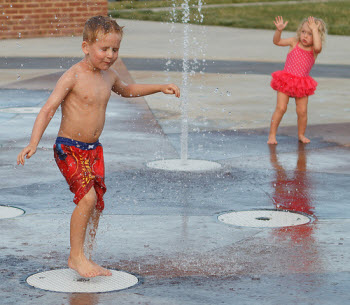 I give a lot of parenting talks, and one of the most common things that parents express to me is that they want to raise resilient children. What do they mean by this? They want their children to be able to have the inner strength to keep trying when things don’t turn out perfectly, to be able to bounce back from disappointment and to take on challenges. But what builds resilience in children? What does that process look like?
I give a lot of parenting talks, and one of the most common things that parents express to me is that they want to raise resilient children. What do they mean by this? They want their children to be able to have the inner strength to keep trying when things don’t turn out perfectly, to be able to bounce back from disappointment and to take on challenges. But what builds resilience in children? What does that process look like?
Like it or not, our children learn more from what we do than what we say. What we do know is that people with resilience have a supportive network in back of them. You, as the parent, are an integral part of your child’s supportive network. You create and represent the ground from which your child can learn, take risks, make mistakes and return to safety. This is happening all of the time. You don’t always notice.
Last summer, I was teaching a workshop at the Family Medicine Department at Thornton Place and took the opportunity to eat outside in the sunshine during a break. Sitting adjacent to me was a mother and her two children — a 4-year-old boy and a 2-year-old girl — chatting with one of the mother’s friends. After they finished their lunch the children became distracted by a nearby fountain. At first they ventured close enough to feel a little spray — and then ran back to Mom. They then returned to the fountain, this time getting a little closer… and then ran back to Mom. Each time their mother would briefly pause her conversation with her friend, meet each child’s gaze and mirror excitedly his or her sense of discovery, then the child would turn and run back to the water. Over and over they ran back and forth daring to get a little closer (and a little wetter) each time. And each time they returned to Mom, she acknowledged and welcomed them — and then they ran back. It was fun to watch the boy slowly take slightly bigger risks and run back less and less frequently, while the 2-year-old took longer to arrive at her sense of safety playing in the water on that warm summer day.
You similarly can create stable ground for your child so that he or she can take on challenges in lots of different ways. How about these?
You notice that when your child is hurting it hurts you too — and you are able to calm yourself so you can notice and acknowledge your child’s disappointment or wounding and let him tap his own inner resources to cope before you rush in to help.
Through occasionally challenging moments in your family, you learn to appreciate your child’s strengths. (Very few of us can appreciate these in the moment — but even afterwards, acknowledgement makes a difference.) It can seem like your child is stubborn, but through these interactions you can see her persistence and determination. She seems emotional and you can appreciate her sensitivity. When you can see the human being behind the behavior, your children learn to not take things so personally.
You model the courage to be imperfect by sharing some of your struggles, your mistakes and your challenges. Your child learns that he doesn’t need to be perfect either.
You model gratitude by sharing what you appreciate when it comes up as part of a dinner or bedtime gratitude ritual. Your children learn that even when things are a bit rough, there is always a place for appreciation.
You are your children’s landing pad and you’re helping to build their resiliency, little by little, as you parent, every day and in every way.
Ten ways to nurture resilience in your children:
- Let them struggle. In our effort to keep our children happy we often jump to the rescue. The sense of mastery is critical to resilience and often there is some discouragement and discomfort on the way to mastery.
- Take care of yourself. Learn to manage your own discomfort when your child isn’t happy (on the way to learning a new skill or taking on a new challenge).
- Model mistakes. Children often see adults as fully capable — partly because we aren’t open about our mistakes. Practice announcing all your mistakes by saying, “I made a mistake but I’m okay.”
- Model fixing mistakes. Share how you felt when you made the mistake and how you went about fixing it or even how you are struggling to come up with a solution. Some mistakes are hard to fix! Wouldn’t it be nice if your children could learn that it is hard for you too?
- Stop and listen. Sometimes our children need us at really inconvenient times. Put down the phone, the spatula, or the computer for a few moments and listen. If it is really impossible to stop what you are doing for three minutes, at least pause for 15 seconds and tell your child that you want to give him your undivided attention and set up a time (soon) when you will find him so you can listen with the attention he deserves.
- Share the load. Children over 2 years old can share in family work. This is more than just cleaning their room, it is a contribution to the family. They can sort silverware, run the dustbuster, set the table, help cook or do other chores that benefit the whole family. Children who contribute grow a sense of “I am capable and I matter,” and this sense in turn is correlated with resilience.
- Connect before correct. See the world from your child’s eyes and name the feelings you sense. “It seems like you are disappointed because it is bedtime already. You were having fun and it is hard to stop.”
- Have faith in your child. It is hard to watch kids struggle, to make mistakes or to experience pain, but if you keep track of the times your child has handled adversity you’ll gradually be able to have more and more faith in her. The amazing thing is that as you do that, your child will also have more and more faith in herself.
- Know your child’s strengths. When your child is in the middle of a struggle (and he hasn’t totally lost it), it can be helpful to remind him of stories of his own life where he overcame adversity. “Remember how hard it was for you to cross the monkey bars. Remember how the other kids made it look easy? Remember how hard you worked and then how satisfied you were when you made it? Now of course it is easy for you. But only because you practiced and you were determined and really persistent.” Do this carefully by using what you know about your child. Remind your child of his strengths.
- Take time to rest and play. When we as adults model resting and playing, we have more energy to handle adversity ourselves. We are also teaching our children a skill that will be useful to maintain their own resiliency for the rest of their lives.
 About the author
About the author
Jody McVittie, MD is the executive director and cofounder of Sound Discipline, a local non-profit dedicated to teaching people to do the right thing, even when no one is looking. Sound Discipline works with schools and families in the Puget Sound Community.
Jody has been working with families since she got frustrated with her own family at the ripe age of 3. Needless to say her skills have improved a little since then. She is now a much in demand speaker to help families deal with the kind of know-it-all demanding 3- (and 13-) year-old she once was. And, as her children (now young adults) remind her, she was far from a perfect parent. She is grateful for what she continues to learn from them.









